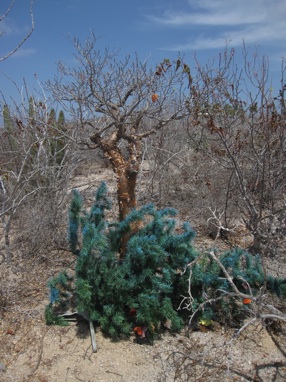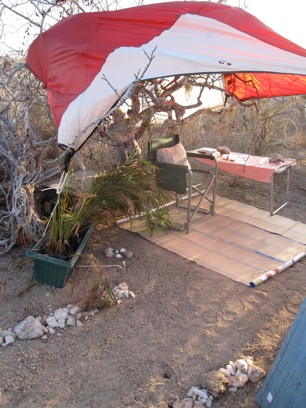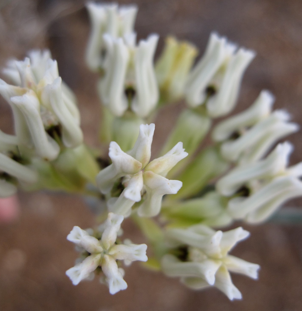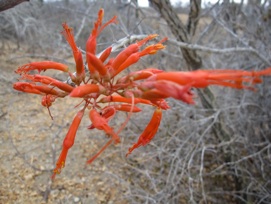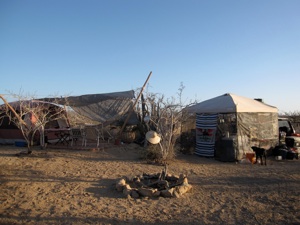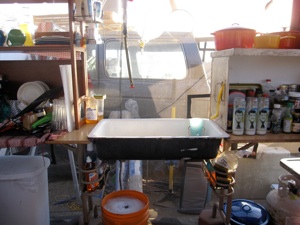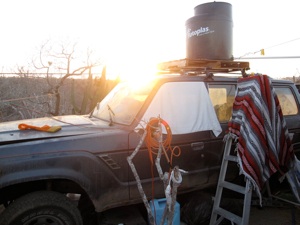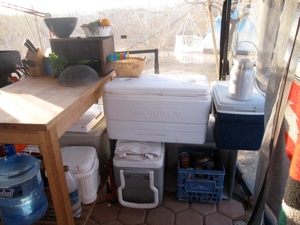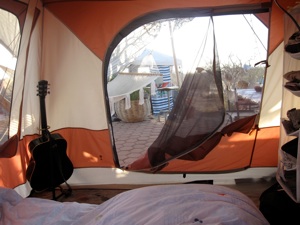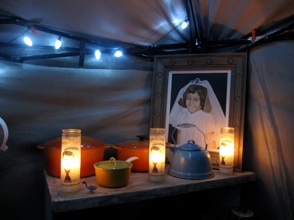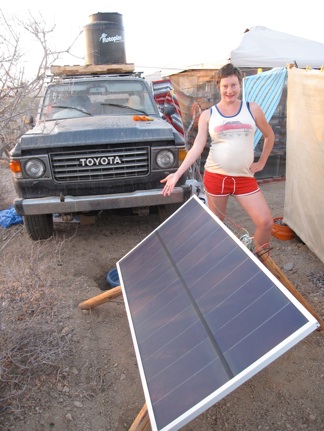ZOËLAB: THE LIFE AS ART BLOG
To Do
This is my to do list for the day.
ZOËLAB DAY 99
Date of original post: December 8, 2012
This is my to do list for the day.
One day I made a heading to a list called House Projects, and Emilio drew on it before I ever made the rest of the list. I saved it because I find it beautiful and funny, and also because it’s a reminder that life should not always be about to do lists. I can be a little much with all my to do lists. Sometimes it is better not to accomplish anything and just be. Lately, I have been off balance. Trying to do too much, with too little time to relax, to be in a receptive mode, which is an integral part of the creative process.
Emilio is is now making to do lists. Sometimes he takes a pen and a piece of paper and says that he needs to make a list. He looks up thinking about what he will put on his list, and then he scribbles word like images on his page. Through imitation, children are the best reflector of our habits.
Zoë's Mediterranean Salad
Finally publishing my famous Mediterranean Salad Recipe!
Well this is a first for me. My very first blog post about food. It's not that I don't love eating or love talking about food, but I have never loved writing about food. It's one of a few subjects that doesn't really grab me. But, I've been receiving so many requests lately by my friends who live in Baja, where it's still hot, who are looking for ideas of recipes they can make with out cooking. So I have decided I am finally going to share my famous chickpea salad recipe that I invented about 12 years ago, and have been perfecting ever since.
It all started in Oakland, when my friend Marie came over for lunch and I made several different Mediterranean-inspired dishes - fava bean salad, tabouli, greek salad. There were a lot of leftovers, and I combined them and thought, wow, that's even more delicious! For the first several years of making this dish I used whole wheat couscous, until I realized that it was much easier to find rice in Baja, and it tasted even better with rice.
So here is the current version of this salad. It's a one pot meal, as they say, which is fabulous to take to picnics and potlucks. And includes all the food groups (except meat). You can omit the feta cheese if you want, and then it's a vegan meal too!
Oh, and I must mention this is one of my all time favorite meals that my whole family loves.
Zoë's Chopped Mediterranean Salad
(serves 4-6 as a main dish, with lots of leftovers)
1 cup rice (White or Brown)
3 cans chickpeas (depending on taste)
1 cucumber, peeled
1 red pepper
1 yellow pepper
A few handfuls of cherry tomatoes halved (or chopped tomatoes)
1 green apple (other varieties will do as well)
1 sweet white onion
1 bunch of green onions
1 bunch of finely chopped parsley
1 bunch of finely chopped mint
1 - 2 lemons (depending on taste)
Feta Cheese (optional if you are vegan) (amount to taste)
Olive Oil
Chopped toasted almonds
Cayenne (optional)
Cook the rice ahead of time and let cool completely. Drain the chickpeas and rinse. Chop all ingredients into bite size cubes and throw them into a large bowl. Mix them completely and then add olive oil and lemon to taste. Keep stirring and keep tasting until you are pleased with the balance. Add plenty of salt and pepper and I love a bit of cayenne as well. Serve with the toasted almonds on the side, as you will have leftovers and the almonds should not be left mixed with the salad lest they become soggy. If you serve it the next day, I recommend squeezing additional lemon on right before you eat it as the acid mellows over time.
Of course there are endless variations on this dish, but I recommend you try this recipe first and then start substituting and playing. Feel free to comment below with your substitutions.
For those of you who live in Southern Baja, I recommend the feta cheese from El Sol market. It's in the fridge, in the cheese section. It comes in an unlabelled clear plastic container, and it's local and delicious. One container should be enough for one dish.
Projects, Parenting & Spray Bottles, Part Four
Anytime my activity at hand is seen by Emilio, not as something getting in the the way of my attention towards him, but rather something he can be part of, is a step in the right direction. It means that I can have a life other than being his mom that he can witness. It makes our relationship more mutual.
ZOELAB DAY 91
Original Date of Post: November 30, 2012
Anytime my activity at hand is seen by Emilio, not as something getting in the the way of my attention towards him, but rather something he can be part of, is a step in the right direction. It means that I can have a life other than being his mom that he can witness. It makes our relationship more mutual. This is a natural phase of development, when the child is no longer only interested in the parent entering his world, but when he wants to enter the parent’s world. I think it’s important, especially for a preschool kid (in this case preschool really means at home, not yet in school) to see that his mommy has a life other than him. For the first time as a Mom, I am allowing more of the other parts of my self into my relationship with Emilio.
That being said, there are still many daily activities that I can do only when Emilio is asleep or away.
All Alone Activities
Reading
I don’t think I have the ability to concentrate on reading in his presence. For this reason, I don’t read as much as I’d like. But I should give it another try. I certainly read him books all the time. Sometimes I try to make it fun for myself by thinking the reading as an acting role or by allowing myself to get lost in the world the illustrations create. For this reason, I try hard to find books for Emilio that I love to look at too. That way I am getting to have an aesthetically inspiring experience while reading to him.
Writing/Blogging
If I attempt to work on my computer in his presence, he will immediately zone in on my computer, want to sit on my lap and ask to type, click on random images on the screen with the cursor, or ask to watch something. (He used to hum and haw and beat around the bush for a few minutes (Mamma, how’s your ipod doing? orA movie would be really fun, do you like movies?” before asking. Now he just cuts to the chase: “Mamma, I’m angling to watch a movie.”) But, if I am writing in my journal or writing notes on random scraps of paper, he will grab a pen and a piece of paper and say that he is writing a list or notes too. He creates his own version of writing.
Making Music
Since he was a baby Emilio protests dramatically every time I pick my guitar. I think it has something to do with where it’s placed on my body--I imagine he sees the guitar as a block between him and me. And he’s right, in a way. I really hope this will change some day, as it means that the only time that I can feel free to play guitar is at night. It’s the same with singing. Since he was a baby, I sang Emilio Summertime before he went to sleep until one day when he yelled in protest when I tried to sing him a lullaby. He no longer wants to tolerate my singing--which is not so easy for me to take as singing both my deepest expression and insecurity. There of course are some exceptions, and Emilio and I have made music together on a few rare occasions. One time we made up a song together that I recorded--see I’m a rock-n-roll thing. There was a brief period when we had “family band” practice. Me on guitar, Emilio on drums, and Lucas on recorder.
I suppose the lesson in this is to be willing to compromise a little: to find ways to include Emilio in what I’m doing so that it’s fun and satisfying for both of us.
Note to reader: For more about this subject matter and to see photo of Emilio sprayinghis water bottle in the shower, check out Attention. Also see Art with Children.
Projects, Parenting & Spray Bottles, Part Two
It’s only been a few days of this new approach, but so far I am encouraged by how much I’m accomplishing while still giving Emilio the attention he needs.
ZOELAB DAY 89
Date of Original Post: November 28, 2012
General home upkeep is also now an activity I do while Emilio is awake or around—I also don’t like tidying the house at night, and now that I have deemed it a daytime activity, I can be more engaged in the process of cleaning or organizing, while still being partially engaged with Emilio. I can give him some attention, by engaging in his play by asking him evocative questions, while at the same time accomplishing house care: sweeping, tidying up, etc. It’s only been a few days of this new approach, but so far I am encouraged by how much I’m accomplishing while still giving Emilio the attention he needs. Of course it helps that we have just returned from a trip, so we are both happy to be home--Emilio with a reinvigorated attitude towards his toys, and me with a reinvigorated attitude towards returning to my projects and organizing our home (partially in preparation for the next wave of objects from our past that Lucas will be carting back in the trailer and the fast coming tourist season.)
Mopping
House cleaning and organizing can also be a full-attention parenting activity. In other words a joint activity you can do with your child. One rare day I felt like mopping the floor to our house (like dishwashing, mopping is not on my favorite house chore--I strongly prefer sweeping or wiping down surfaces), and as I got out the mop and the spray bottle (filled with half vinegar and half water-a great natural and inexpensive disinfectant) I saw a glint in Emilio’s eye and I asked if he wanted to help. He wanted to be the one to spray the vinegar water on the tile floor while I mopped the area he sprayed. We both had a lot of fun and felt equally motivated to clean the entire floor this way. I felt a deep satisfaction at having a clean space, and all the more so because we had managed to accomplish and make fun, a chore that I had always found tedious. And I didn’t have to spend any precious alone time doing it.
Wiping Surfaces
On another day, we decided we wanted to use the coffee table to draw, but it was dirty and needed to be cleaned. Again, I got out the spray bottle and a rag. I let him spray the entire table with the spray and wipe as much as he wanted, and then I added some finishing touches. After we were done, I felt like I could breathe better. I remarked at how nice it was to have the table all clean. I asked Emilio if he liked having it clean (hoping I could instill a cleanliness gene in him mentally instead of through DNA) and he said “yes.” And then I asked him why. And he said “because we sprayed and wiped it.” What he liked was not the result of table being clean, but the activity in itself, the experience of cleaning. Wouldn’t I keep the house cleaner if I saw it the same way?
Cleaning Up Toys
Another activity that can be done with full attention, and therefore becomes a good parenting moment and a good house care moment, is cleaning up toys. Now because the space we live in is a shared space by three unique individuals (Ping, covered in fleas, does not come in the house--which is the Mexican way with dogs) , it is easily overtaken by any one of us. I find that I feel happier at night if Emilio’s toys are already put away. I also think tidying up is a good skill for him to learn. Therefore, another one of the evening rituals I try to do is clean up toys as part of bedtime routine. I dangle the three books he will have for night time as a motivator, which usually works, unless he is so tired that he will resist just to resist. In which case I don’t ask him to clean up his toys in order to keep clean up time free of negative associations (you’ve got to pick your battles.) Ihave come up with an organization system, using various containers of shapes and sizes to help contain his toys. Therefore cleaning up becomes as much a sorting game as it does a chore. Even Emilio’s friends know which types of toys go in which containers. For example: the 1950’s white vinyl train case (from Ruth, my mother in law, who, on an overall life simplification jag, dispersed her impressive collection of vintage suitcases and train cases) holds the dolls and doll furniture (I guess some day we will get/make him a doll house), the metal Japanese Snoopy tin holds his collection of 1960’s and 70’s Fisher Price Little People, the cylindrical oatmeal tin holds his magnets (and becomes a great magnet toy in itself). My point is that cleaning up can be challenging and fun when it’s a sorting game. Sometimes as an extra motivator I add the challenge of competition-the point system. Every time someone puts a toy in a container I call out “I got a point. I got two points. You got a point” and so on. It’s just like a basketball game, but there’s lots of balls and we put them in the same hoop. This usually works in getting Emilio to put away his toys, but sometimes he still resists, and then his own internal motivator kicks in--he makes a new game where he finds creative ways (usually involving toes) to pick up the toys and put them in their appropriate container. It’s not as quick as my point method, but whatever works in the current circumstance is what’s best.
To be continued...
Note to reader: the power cord to my computer just burnt out on me, which means that I will not be able to charge my computer after it dies, which means I might be delayed in getting the next posts out until I can borrow or buy a new one. Yikes!
After the Rain: a photo essay
Every summer, a bunch of our stuff gets ruined because we leave it outside before the rains come. This may seem shocking to some people. But we are developing a new philosophy that accepts the fact that we own far too much stuff, and that nature sometimes has to do her thing. I could be more careful, but somehow it hasn't happened yet. And it makes such an interesting art project to capture what nature does to culture. (And vice versa).
Every summer, a bunch of our stuff gets ruined because we leave it outside before the rains come. This may seem shocking to some people. But we are developing a new philosophy that accepts the fact that we own far too much stuff, and that nature sometimes has to do her thing. I could be more careful, but somehow it hasn't happened yet. And it makes such an interesting art project to capture what nature does to culture. (And vice versa).
The artwork was from a series I made in grad school, and the photos were prints I made in the dark room in college. The police car is Emilio's.
Creativity is about creation & destruction.
I think I am going to add some of these to my Culture-n-Nature Gallery.
Latest ZOELAB Album Cover
One of my favorite things to do as a designer is make album covers. Garafön, my band with my husband, will be releasing 15 -20 songs over the next months, or years (we'll see how long it takes me to learn how to a producer/recording engineer on top of a songwriter, singer, guitar player), so I will have a chance to make an album cover at least 15-20 times. But in the meantime, I am making album covers for zoëlab.
I haven't posted in a while due to a series of illnesses in the family. Everyone is on the mend, but it has taken me away from zoelabbing. In addition to parenting, I have also been working on some design projects, recording my songs, securing a new office space for myself in Todos Santos, cleaning up our newly sealedbedroom building (¡Nada mas murciélagos y guano!), which is now its finishing stages (we started construction in 2012), as well us helping out with the construction of our new guest house (photos of that process coming soon).
One of my favorite things to do as a designer is make album covers. Garafön, my band with my husband, will be releasing 15 -20 songs over the next months, or years (we'll see how long it takes me to learn how to a producer/recording engineer on top of a songwriter, singer, guitar player), so I will have a chance to make an album cover at least 15-20 times. But in the meantime, I am making album covers for zoëlab.
Here is my latest, and therefore, favorite one:
I took this photo of this moth after I discovered it convulsing half stuck under a cement paver stone in front of our house. It was fluttering its wings in a manic way. I rescued it from under the cement (but not before I took a video--sorry moth, but sometimes art must come first). And laid on the ground. It fluttered a little longer, and then it was still. And then I took this photo.
I must say finding the moth in the state it was in--felt like a message from the universe. A direct mirror of the feeling I've been going through lately. Impatiently trying to flutter my wings and fly, but realizing I am not quite ready yet, and therefore, still need to be on the ground. Once I freed this moth, it wasn't ready to fly yet either, and was still for a long while. I tried the same thing, and it worked. I started resting more. Slowing down. And then I got sick! Ha! My body and my psyche knows what's up. And so does the moth.
Another way that a storm is like a dinner party
Treating the storm in this way, with acceptance, and respect, almost an invitation, felt right. And it reminded me of one of my favorite Rumi poems that I return to over and over.
The Guest House
This being human is a guest house.
Every morning a new arrival.
A joy, a depression, a meanness,
some momentary awareness comes
as an unexpected visitor.
Welcome and entertain them all!
Even if they are a crowd of sorrows,
who violently sweep your house
empty of its furniture,
still, treat each guest honorably.
He may be clearing you out
for some new delight.
The dark thought, the shame, the malice.
meet them at the door laughing and invite them in.
Be grateful for whatever comes.
because each has been sent
as a guide from beyond.
-- Jelaluddin Rumi,
translation by Coleman Barks
It turns out that the storm was not destructive, nothing like Odile. Also, we were more ready than we've ever been. We cleaned the entire house and yard, but with less fear and urgency than usual. Believe it or not, we are starting to get used to hurricanes. And we need to get used to them, as hurricane season has arrived two months early this year. As we prepared for the day, both Lucas and I had the same thought, independently--that getting ready for the storm was like getting ready for a dinner party. It forces you to clean up. All the same things had to be done. When you are off the grid--there's quite a lot to be done. Treating the storm in this way, with acceptance, and respect, almost an invitation, felt right. And it reminded me of one of my favorite Rumi poems that I return to over and over. As, this attitude towards life, not only towards storms, but to our own emotions, helps us to soften in the face of difficulty. We are more prepared, more ready to take on the challenge. We become heroes, facing the impending tumult with strength, but also welcoming.
Hurricane Odile
This morning we learn a hurricane is coming—Odile. A category 4, with 125 mile an hour winds, which would be the most ferocious hurricane of recorded history to hit this peninsula.
PART ONE
Tuesday, September 16, 2014
This morning we learn a hurricane is coming—Odile. A category 4, with 125 mile an hour winds, which would be the most ferocious hurricane of recorded history to hit this peninsula. It is expected to be a direct hit. It is supposed to come in the evening, but it could arrive earlier—so we work as quickly as we can. We spend the day of Sunday preparing for our imaginings of its wrath.
PREPARATIONS
In our unfinished brick bedroom building, Lucas takes cracked plywood boards (which had been left over from the building materials that Marcos and he used to build our houses)—and nais them to cover the two glass windows of the bedroom building. He nails a large piece of plywood to the front door which previously was used to block the space between the bathroom and our unfinished bedroom. He tapes x’s onto the windows with blue masking tape. He finally gets around to inserting the glass piece that had been missing from my unfinished design nest window into its gold painted frame. Lucas piles up every waterproof plastic case (filled with my vast collection of thrift store clothes) to prevent the french glass door from blowing in. Next, he inserts bricks (we have many left over from the construction of our bedroom building) into the window openings to prevent water from completely flooding the building. We take everything we can off the floor—piling our clothes and other items on top of vintage metal lockers, hampers, and tables.
In the main house, we sweep the floors in order avoid unnecessary mud, cover our bookshelves, chairs, and musical instruments (mostly in cases) in plastic tarps. As news of Odile’s intensity progresses, our plans of where we are going to sleep change—our first plan is to start in the bedroom, and then if it gets too wet in there, we can retreat to the bodega. We soon realize that we would be better off in the bodega—which still leaks badly—but it had the fewest openings of all our spaces, and a cement roof. We know from previous rainstorms that the roof leaks, so Lucas ingeniously rigs up (as is his specialty) a sleeping space in the disorganized, overcrowded bodega, which begins with a platform of stainless steel metro shelves (wire racks) to keep us above the water line. He piles our tumbling mat on top of that. Then he resurrects what we had deemed an usable two person tent, which had bent poles (due to rowdy play by Emilio and and his friends), knowing, that even in its broken state, it is our best option to protect us from unwanted bugs and errant raindrops coming throughout the ceiling or front door. For a mattress, he takes what had previously served as our couch cushion (originally taken from an old camper.) After Lucas sets up our sleeping arrangements we feel a little more relaxed. Knowing that if worse comes to worse—which in our minds is the complete destruction of our palapa roof. (A palapa is a roof made entirely of dried palm fronds, woven tightly together over wooden beams. No metal is used in their construction.) We had before experienced a partial roof blow off in our first Baja hurricane —Jimena in 2009—a few weeks after baby Emilio was born. Our other very likely to happen fear is that our bedroom building will be completely flooded—as it had during Juliette last summer. The water had literally poured through the wall of bricks. Juliette had taken us by surprise—a tropical storm with 50 mile an hour winds.
Other preparations include shopping for extra water, gas (for the generator) and food (including candy bars, Special K, and beer to keep up the morale of the troops), filling the above the roof water tanks with water (both to ensure that we have extra water in case we need it, and that the tanks will be sufficiently weighed down as to not blow off the roof), cleaning the kitchen, making sandwiches for dinner in case cooking will not be possible, charging laptops and batteries for headlamps and flashlights, filtering extra drinking water, creating a water proof case of emergency provisions, and letting Emilio watch videos all day so as to occupy him while we focus on our tasks and so that he is in good spirits—which he absolutely is. “I love this day!” he exclaims regularly. As we prepare, we have visions of Cabo being covered by water—and us being roofless, stuck for days—all of our stuff wet and/or blown around the valley. We think it’s possible that this storm will change our lives forever. We don’t fear for our lives, but we are concerned about the amount of damage done to our our community. We know that if Cabo goes down, and our local towns flood and suffer major damages, the economy of this place will be majorly altered. Lucas will have to alter how he makes his living, which is primarily as a photographer in Cabo. We also know that the local palaperos (builders who specialize in making palapas) will be busy for months.
Storm Progresses, we lose connectivity
We have disastrous images in our minds while we do all we can to ensure our safety, comfort, and the protection of our stuff—but the truth is: we really have no idea how the hurricane will affect us, and when exactly it will hit. And that, is, by far, the worst part. The unknown fills us with a steady stream of adrenaline through the day. Lucas constantly checks our hopelessly slow internet connection in hope of weather updates—knowing somewhere inside that these updates don’t really offer much as there is nothing left for us to do except await mother’s nature’s wrath, but still, for him, it assuaged the unnerving feeling of having no information. We know it is only a matter of hours before our cell phone and internet service will be out—they both come from the same source—a TelCel tower a hundred kilometers away on top of a hill, which we can see in clear view from our house. Whether or not we will continue to have electricity was not clear. We are now fully on solar power, and have a back up generator. But, our solar panels are on the roof our bodega—which is attached to our main building. They are securely wired down, but you never know.
The day is over, and evening has arrived. We have lost connectivity. The immediate order at hand is to eat our sandwich dinner, and get Mio to bed safely in the tent before the Odile hits. It is already raining and storming, but we know it will get worse. Much worse. We know that if Emilio falls asleep before the hurricane hits, which is supposed to be at about midnight, he will sleep through it as he had with Jimena & Juliette. Lucas has made the tent space nice and cozy, and after a bedtime book, Mio has no trouble falling asleep. I lay awake for a while in the tent—listening to the storm trying to knock its way through the metal doors of the bodega. I can hear Lucas pointlessly mopping—pointlessly trying to keep the tile floor of the living room dry. I join in him in the living room—and tell him he might as well let the water come now, we can clean it up when the storm is over. He feels he must do the mopping—as it is all he can do, and it comforts him to do something. I decide it’s time to drink some alcohol to calm my nerves. Lucas has a bottle of Sambuco, a liqueur of licorice. I drink as much as I can until the jangle is gone from my nerves. Lucas and I sit there chatting, with a jokey, we’ve done the best we can to prepare, but we’re still terrified spirit. There is something about that feeling of surrender—when you know you’ve done all you can, and the rest is beyond your control that is both comforting and humbling. It reminds you how human you are, and therefore how small and inconsequential, when faced with the momentum-building fury of mother nature on its way over to visit.
Retreating for the night
At around eleven I convince Lucas of the futility of mopping and persuade him to come to bed— we can try to get a little sleep before the really loud sounds come. We retreat into the tent, inside the bodega, which is not exactly dry—but it is the driest spot there is. I charged my iPod earlier, knowing it would be an invaluable mind distraction and sound blocker. Intuitively, I know my job is to be calm and optimistic. Lucas comes up with his own method of blocking out the sound—squeezing a pillow tightly over each ear. Mio continues to sleep soundly. His comfort is a comfort to us.
The sounds we have been expecting come—bone chilling, earth-trembling, god-fearing sounds. We know where they came from—-it’s the metal roof getting torn off the part of our main house that is not covered in palapa. It comes off in pieces—every hour we hear another piece tear off. We imagine it smashing everything in its path, including our cars. I continue to listen to my ipod—first I listen to the last music practice session with Lucas, then I listen to an hour of solo practice from a few days earlier (after a kundalini class my voice was particularly resonant and confident) and perceive this practice as a voice breakthrough. This kind of listening gives me solace while the wind wrecks havoc on our homemade home still in process. Then I listen to a most inspiring podcast—a TED talk by the monk David Steindl-Rast. He communicates simply, eloquently, with great compassion the simple fact that gratitude creates happiness and precisely how this works. Here is a chunk of what he says: “We experience something that’s valuable to us. Something given to us that’s valuable to us… These two things have to come together. It has to be something valuable, and it’s a real gift—you haven’t bought it, you haven’t earned it, you haven’t traded it in and had to work for it, it’s just given to you and when these two things come together… then gratefulness spontaneously rises in my heart, happiness spontaneously rises in my heart. That’s how gratefulness happens. Now the key to all this is that we cannot only experience this once in a while, we can not only have grateful experiences, we can be people who live gratefully. Grateful living—that is the thing. And how it can be lived gratefully is by experiencing, by becoming aware that every moment is a given moment as we say. It’s a gift! We haven’t earned it, you haven’t brought it about in any way… you have no way of assuring that there will be another moment given to you. And yet, that’s the most valuable thing that can ever be given to us. This moment with all the opportunity that it contains, if we didn’t have this present moment, we wouldn’t have any opportunity to do anything or experience anything, and this moment is a gift… What you’re really grateful for is the opportunity, not the thing that is given to you because if that thing were somewhere else and you didn’t have the opportunity to enjoy, to do something with it, you wouldn’t be grateful for it. Opportunity is the gift within every gift. And we have this saying “opportunity knocks only once”, well think again. Every moment is a new gift! Over and over again. And if you miss the opportunity of this moment, another moment is given to us, and another moment. We can avail ourselves of this opportunity or we can miss it. And if we avail ourselves of this opportunity it is the key to happiness. We hold the master key to our happiness in our own hands. Moment by moment we can be grateful for this gift. Does that mean that we can be grateful for everything? Certainly not… we cannot be grateful for violence, for war, for oppression, for exploitation. On the personal level, we cannot be grateful for the loss of a friend, for unfaithfulness, for bereavement, but I didn’t say we could be grateful for everything, I said we can be grateful in every given moment for the opportunity. And even when we are confronted with something that is terribly difficult, we can rise to this occasion and respond to the opportunity that is given to us. It isn’t as bad as it might seem. Actually, when you look at it, and experience it, you find that most of the time what is given to us is opportunity to enjoy and we only miss it because we are rushing through life and we are not stopping to see the opportunity. But once in a while, something very difficult is given to us and when this difficult thing occurs to us, it’s a challenge to rise to that opportunity and we can rise to it by learning something which is sometimes painful. Learning patience for instance. We have been told that the road to peace is not a sprint, but it’s more like a marathon and that takes patience, that’s difficult. It may be to stand up for your opinion, to stand up for your conviction. That’s an opportunity that is given us. To learn, to suffer, to stand up. All these opportunities are given to us, but they are opportunities and those who avail themselves of those opportunities are the ones we admire. They make something out of life. And those who fail get another opportunity. We always get another opportunity. That’s the wonderful richness of life.”
Listening to his words as the hurricane rages outside is life-affirming. No matter what the destruction that we will discover the next morning—we will have the opportunity to continue to live, we will have a chance to re-create our life how we need it to be. It will be difficult, and it will be messy—but we will still be grateful for what we have. We will survive and we will continue to appreciate the life we have built, and the fact that we are still a family in tact. There is nothing like outside threats to strengthen the bonds of a family or community—as long as we are grateful. We were bonded together in our tent, and Ping—who is the most nervous dog I have ever known—-is huddled against my body, on the outside of the tent. I can feel his shaking through the thin nylon. We had to lock Ping inside the whole day to assure he would not run away out of fear. His response to danger is flight. He hears loud noise and his legs just start running. No part of his mammalian brain is available to him. He had previously escaped a few times during this especially stormy summer on the days we left him at the property and surprise thunderstorms came.
A New Day—counting our losses
The storm rages all night long and through out the morning. Between the two of us Lucas and I sleep about an hour. Emilio sleeps until morning. Bless that little sleeper. Early in the morning, Emilio and I wake up and unzip the damp tent—we step through the flooded floor of the bodega into the main house. Odile is still expressing himself—wind and water blowing around—but less so. Everything is a wet mess of water, dirt and leaves, but the palapa roof, made with not one nail or screw, is miraculously still there. It is roughed up, and there are holes in it, but it covers us. All of our windows are in tact. We step outside—the vision breaks my heart. The only thing I have not previously imagined is how the plants would fare. I am not prepared for what I see. The circle of trees is mostly flattened. Our beautiful Neems (the only trees on our property that we have planted that are now almost mature) have all their leaves blown off—they are all more or less sideways. Our three Terote trees—the three naturally standing trees that Lucas built the brick bedroom building around— are badly damaged—limbs have been torn off—even the bark itself is stripped bare in places. The wood that Lucas nailed to protect the windows has been pulled off. We see pieces of roof from four different roofs scattered all over the land. The rainproof plastic roof over the kitchen is completely gone—there is still the lower layer of plywood covering it—with the inner layer of plaster falling down in chunks all over the kitchen. The metal roof (photo or link to previous post) over the art camper is missing except one piece. Now here is the real miracle—the camper is almost completely dry—except for one small puddle on one of the counters. We had thought the camper to be not at all waterproof which was why Lucas had scrambled before Juliette to build a waterproof roof over it. All of my precious art supplies and art work and books are not damaged! I continue to have a real respite in my camper. My beloved garden that I had planted next to the camper is quite damaged. Most of the leaves were blown off, the plants have been knocked down or repositioned at deep angles—but on close inspection, I see that they remain rooted. A blessing! I lament them anyway as is my tendency when there is any sign of losing greenness in our desert dwelling. It takes so much effort to keep a plant thriving when we do not have an irrigation system, and the summer can be so hot when there’s no storm. The rainstorms all summer have been good for the plants—and now all of that growing green has been stripped out. The paint on Lucas’ truck was also been stripped off in sections—as was the paint (applied only one year ago) of parts of our house—literally sandblasted off.
The two water tanks that Lucas filled yesterday, which provide the main source of house water (using a gas generator we pump the water from our large water tanks at the bottom of our property into the two tanks above our house that through pressure of gravity, provide our sink water and toilet water for flushing) have been knocked off the roof. One is beyond repair, and one may still be usable. Lucas realizes that the connection to the tanks has been severed, which leaked all of our water out, then allowing the wind to blow the empty tanks off the roof. The large metal bodega doors are damaged and will need to be replaced. The bedroom building is a wet, chaotic mess, but most of our stuff was not damaged. All of our clothes that were not in storage cases will need to be dried out in the sun. The wood that Lucas had nailed to the windows and had put to block the open front doorway were torn off by the wind. None of the glass was broken except for, ironically, the one piece that Lucas put in the day before in an attempt to keep some of my design nest stuff dry.
Counting our Blessings
Our solar panels did not get blown off the roof. And, they are still hooked up properly and are working. We have electricity! Even our fridge—which runs on its own solar panel and battery is working. We have no running water in the main house—but our lower storage tanks are full enough to last us a while. We have some water in our bedroom building so we can take showers there. For now. We are stocked with food, and basic medicine and first aid supplies. Our Peruvian neighbors, who recently moved back to their land, and we have become friends with—checked in us to see how we were. We both reported we were fine—their house is even less finished than ours.
It has become easy for us to count our blessings because we are reminded daily of the conveniences and comforts we now have that we didn’t start out with. Beginning with camping on our land (which we didn’t yet legally own) while I was pregnant, our life over the past six years has been a gradual increase in self-sufficiency, comfort, convenience and freedom. We also received lots and lots of help—from our families especially, but also from friends, and neighbors. Not always, but often it is natural for us to appreciate what we have, instead of focus on what we have lost because we have gained so much! Part of the reason we live the way we do—out here in the desert wilderness—is because we are aware that the world will bring and more more disastrous types of situations. Global warming brings more storms, and dwindling resources brings more desperation to people. This is Lucas’ grand project—being prepared, just in case. We discovered recently there is a term for what he is: “a defensive pessimist”. It’s not a very flattering moniker, but it fits. I think he feels affirmed by the fact there is a term for what he is. A defensive pessimist is defined as a person who imagines the worse case scenario, and then plans for it so as to feel assured. That is the kind of person you want to live with if there’s a real disaster on its way. I am quite sure I would have had no idea what to do with out Lucas, who not only is great at thinking through possible catastrophes, and coming up with ingenious solutions on the spur of the moment—but he also invents and designs future projects with all matters of nature, both destructive and creative, deeply in mind. If he’s a defensive pessimist, that makes me an offensive optimist. That feels about right. To some people my optimism probably is offensive. But, I am good to have around during difficult times because my goal is to keep up the morale of the troops, and I do so love a good adventure. I think of all the goodies that creates little moments of comfort, fun or pleasure.
Odile’s wrath immediately cut through our indecisiveness, mental blockage and distraction from the important stuff of life. The storm awakened in us—even in moments while it was happening—a sense of celebration of life—of our gratitude to being given an opportunity to go on living with greater clarity, purpose and appreciation. The storm re-affirmed for us what previously had been wavering, let each choice or commitment we had made to come forward and announce itself, or otherwise retreat into the background and then let go of. With all the land a mess—our beloved trees damaged, much of our stuff wet, damaged, but most of it, not—we could appreciate what was left—a home that shelters us (mostly), a beautiful piece of land in the foothills of a beautiful valley surrounded by mountains and ocean. For Emilio—it was all an adventure or perhaps non-adventure (it can be hard to tell with him)—either way, he got a few days with his family all together, all focused on the same goal, as he got to have the normal rules loosened in favor of more movies and more treats. As for me and Lucas, we still have the same dreams, and the same personalities—but our dreams feel more precious and are in sharper focus. Our personalities shine—the positive forging ahead, old habits disintegrating. For Lucas—he has been dreaming of his next weatherproof house design. And for me—I feel a greater resolve to build community through the arts, work on my creative projects and develop my thoughts and ideas and share them with you here.
We have yet to learn of how others’ fared, but we are quite certain, overall, we are some of the lucky ones. I am bracing myself to hear of the devastation in Cabo, which I am sure will be severe. Cabo already is a place built quickly, cheaply, with little taste, and no planning. The communities that we are connected to—Pescadero & Todos Santos, and to a lesser extent, La Paz—will have their own struggles to overcome. But for now—there is no internet, no phone, and the road over the bridge has a gaping hole in it, and we are not sure if anyone is driving. I will post this as soon as I can find a place that has an internet connection.
The view from our courtyard from our roof.
Emilio pretending we have cell phone service, calling Snoopy to tell him of our troubles.
To be continued...
Backwards Night Dreaming About Camp
How beautifully simple life was when we camped here. Not that it was easy, but it was a special and peaceful time. I realize how lucky I was to have lived in nature while I was pregnant--ocean, mountains, desert, and also: dessert.
ZOELAB DAY 78
I have been so busy lately. Working on ZOELAB is the only time of the day where I don’t feel “busy.” Or when I watch television, though television is still being busy, because we aren’t really present when we’re that passive. (I must confess I fell off the television wagon the other night, and instead of creating with ZOELAB, I watched four episodes in a row of The Sopranos. God, I forgot how good, and funny, that show was. Carmella is my empowerment heroine.) Anyway, what is busyness but preoccupation with things that don’t exist in the present. I really don’t like being this busy--when we’re busy, we start to accept stress as a baseline emotion. I want to remember the reason we live here, in Baja, in the desert next to the Pacific ocean, is so that we don’t have to be so busy. So that we can be more relaxed as parents, and as a family. So that we have more time to be creative and social. So that we can have time to just be. But, with parenting, work, and all our various projects, we are living in the busy world.
Trying to find inspiration for sharing on ZOELAB, I started looking through some old writing and found a list I had made for my first blog, almost four years ago, of pluses and minuses of living outside, while we were camping on this very land that we now have a house on. I never published the list. Today I noticed there were 15 items on the minus list. On the plus list, only 14. I added the 15th today, so the two lists would be even.
How beautifully simple life was when we camped here. Not that it was easy, but it was a special and peaceful time. I realize how lucky I was to have lived in nature while I was pregnant--ocean, mountains, desert, and also: dessert.
Pluses vs. Minuses of Living Outside
Minuses
1. Everything gets dirty
2. Sun damage
3. Windy
4. Cold at night
5. Have to dump our toilet
6. Keep food in storage away from animals
7. Lots of prickly, hurty things, scorpions and cholla
8. No cell connection
9. No internet connection
10. No place to hang a mirror
11. Things break a lot
12. Lack of security
13. Lack of comfort at night
14. Lack of entertainment at night
15. Have to take garbage to the dump
Pluses
1. Keeping track of how much water, gas, electricity using
2. More aware of the moon, the stars & the sun
3. Love rocks
4. Peaceful (except for noisy neighbors)
5. No rent
6. No bills
7. Can make as much noise as we want
8. No need for alarm clock
9. Can recycle gray water for plants
10. Hear ocean and birds
11. Perfect for Ping/guard dog/free dog
12. Appreciate the little comforts in life, with each new comfort comes a whole new possibility of life style
13. You can create new spaces freely
14. You never have to worry about parking
15. Being present comes naturally
The Slow Making of a Dream, Third Phase of Building: Bedroom
ZOELAB DAY 77
I am aware that my Second Phase of Building post, the latest and biggest phase of our house building project, is long over due, but now, even though it will be out of order, I am announcing Phase Three. Thanks to my parents, and their upcoming visit in February, we will now be able to finish the bedroom building, which my parents will stay in when they visit. It will be the first time I have had my parents as a guest in our home. Lucas has two months to gather a crew, buy the materials and finish the building. Will he and his men be able to do it in time? Only time will tell.
Above photo is a shot of the North view from what will become Emilio’s bedroom, which is now our clothesline area.
View of our living space building from Emilio’s future bedroom.
Front entrance to building. Emilio’s bedroom will be on the right, ours will be on the left.
Lucas still hasn’t decided many of the important structural aspects of the house, like how he’s going to do the roof, but he’s created the basic design of the building. Lucas is an amateur architect with no training, and a moderately experienced builder, you could call his style of working “improvisational architecture.” But I am not even sure it can be called architecture, it is more like building with giant legos. No matter what I call it, I continue to be in complete awe of his vision and skill, using nothing but his imagination and the internet, in creating comfortable, elegant and unique spaces. This is Lucas’ basic design: there is an entrance in the center of the building, into avestibule, which leads to two symmetrical bedrooms on either side. Each bedroom has a closet that is also located in the center section, and a shared bathroom with an entrance from both bedrooms. This center part of the building is already built, out of cement blocks (the most popular building method around), which was started while the main house was being built. But the bottom part of the walls are made out of earth bags, which a lot of our main house is also made of. More about earth bags when I write about the Second Phase of Building.
Wider North West view of bedroom building from front entrance before earth bags and foundation. Photo taken on January 29th, 2012.
To Do Collage
Indirectly inspired by assignment #56 from Learning to Love You More, mentioned in art world post, I made a collage. It started out free style--I leafed through some old magazines, cutting out images that had significance to me, but instead of being a portrait of my friend’s desires (assignment #56), it ended up being a visual to do list.
ZOELAB DAY 73
Indirectly inspired by assignment #56 from Learning to Love You More, mentioned in art world post, I made a collage. It started out free style--I leafed through some old magazines, cutting out images that had significance to me, but instead of being a portrait of my friend’s desires (assignment #56), it ended up being a visual to do list. As I picked out the images, I realized the ones that had significance to me reminded me of things that have been floating around in my head have I have been needing/wanting to do. I added the letter-punched red labels after the fact, simply because I had just rediscovered the punching gun that Lucas found at a thrift store when I opened my hot pink plastic 1970’s Samsonite suitcase, which is the holder of my vast collection of collage papers, fake tattoos (one made by artist Kiki Smith!), and stickers. (I still have a sticker collection, and stuffed animal collection and I’m nearly 40. I have gotten in heated discussions with my 3 year old son over whose Snoopy is whose.) How fun it is to reconnect with all those wonderful tools. I really recommend trying the visual to do list. I had a lot of fun with it. It loosened the pressure I normally feel when I make a written to do list. It would be interesting to make one that is pure image, with no words. Perhaps the images would start to have an unconscious affect on us, subliminally inspiring us to perform the tasks on the do list. What if the tasks on the list were significantly more boring than the ones illustrated above? That would be the real challenge, making boring tasks like “pay water bill” look enticing to ourselves.
Try making a visual to do list and let me know how it goes. Send me your images!
Three Days: A Poem in Three Parts, Part Two
The next day, the rain came, again.
Every few minutes, a new sound,
A new amount:
A sheet, a bucket, a drop, a blanket.
ZOELAB DAY 46
The next day, the rain came, again.
Every few minutes, a new sound,
A new amount:
A sheet, a bucket, a drop, a blanket.
And inside our house,
the rain came too.
Honey brown stripes down
our 6 month old walls.
Pools collecting on the orange plastic
covering my desk.
Watercolors painted,
Paper soaking
muddy stains.
The wind was next.
With its power
mostly suggested.
Loud because of a tarp on our roof
Ineffectively flapping about.
The fear of destruction
Waking us up at dawn.
The light so dim,
Not from earliness
But from clouds.
The day is given up on
For anything related to production
Or radio waves.
It is time for
mopping and sopping.
Watching and snacking.
Telepathically transmitting:
We are okay.
We are a little bit wet.
The house has been overtaken
By chaos.
A storm within created by
Retreat.
The Slow Making of a Dream Part Two: First Phase of Building
After Campo Elias Calles, and after Emilio was born, we needed a new place to live. It was winter 2010, Emilio was 5 months old. Our friends, who live in La Huerta (a mostly gringo area next to a surfer’s beach, surrounded by farmlands) took us in.
After Campo Elias Calles, and after Emilio was born, we needed a new place to live. It was winter 2010, Emilio was 5 months old. Our friends, who live in La Huerta (a mostly gringo area next to a surfer’s beach, surrounded by farmlands) took us in. They let us live in a small casita on their property, and in exchange for rent, we did chores (childcare, haircuts, house projects, shopping, etc.) By the spring of 2011 we were ready to start the first stage of building. With out shopping around at all, we hired the first worker we met, a guy named Transmission (who had done a little work for our friends’ on their property) to build a fence around our property, which is about 1.5 acres. It doesn’t seem like much now. But then, having that fence meant everything. It meant that even though we didn’t yet have legal ownership, we had possession of the land. Our land had a boundary.
The North East corner of our lot.
Then we had him built a 13,000 liter pila (giant cement water tank). Next, which was really his specialty, he built a beautiful one-sided palapa (made out of pine polls, palo de arco sticks, rope and palm fronds (found in elias calles). No nails or screws are used. The palm fronds are woven in between the long palo de arco sticks.
He also built a small cement bodega (lockable storage space) that would be used to lock up tools during the building process, but would later become our bathroom. One of the walls of the cement bodega would be one of the walls of our eventual house that would be built under the palapa roof. Jutting out from the low side of the palapa, on the North side of the building, is a media sombre pergola (a shade roof made out of palo de arco sticks woven together), and a floor of adoquin (cement pavers) below. That was to be our patio.
This work was done in a few months. We were so happy and so grateful, but the work was far from perfect. The pila leaked (and still does). The bodega door was put on backwards (and it still is). We found out we were overcharged. But still, we were happy, especially with the quality of the palapa which was beautiful (and still is, even though it leaks and has termites eating it.) It wasn't until it was done and Lucas and I came to spend a little time in the space that would become our house that I knew it was real. It had all seemed like a pipe dream until that very moment. I cried and hugged Lucas and everything changed. I knew then, that we really were going to have a house. And I knew, even if I couldn’t see his vision, which was constantly shifting, that I had to believe in Lucas. That he was going to create a beautiful and unique house for us.
The Terrific Freedom and Terrible Loneliness of Expatriating
I find it freeing to let go of the protective grip of the ego that wants to uphold an idealized and restricted view of ourselves, and accept that we all fail as humans. We all make messes. We all feel rejected sometimes.
ZOELAB DAY 27
It’s harder to write these posts when I am feeling down. But writing these posts makes me feel more alive, more connected, and more able to work with whatever it is I am going through. Start from where you are. After all, as the poet, and songwriter Dave Berman (of the Silver Jews) says: “You can't change the feeling but you can change your feelings about the feeling in a second or two.” It is a time of great loneliness and longing for me. I have felt it before. It is very hard to live far away from my dear friends and family. Everyone who lives in the first world seems so very busy out of necessity that the modern urban life calls for, and it seems people don’t have much space in their lives for communion, relaxation and hanging out. This seems like a luxury rather than a right. The friends and family I have here are all away right now--avoiding the bad weather and the boredom. And some more recent friends that I have made here, have decided not to return, for now. I chose to be here for most of this summer so that we could experience the true seasons of this place, and so that I could have a sense of continuity, and because we finally have a home, and I want to be home.
Moving to another country is a terrifying and exhilarating leap of faith. Even in moments like these, I don’t regret it. And I don’t want to leave. I have always been an adventurer and have strived to have as many experiences as I can, and haven’t generally let fear or the prospect of failure get in my way. In fact, as an artist/seeker/psychologist, I am as interested in failure as I am in success. I find it freeing to let go of the protective grip of the ego that wants to uphold an idealized and restricted view of ourselves, and accept that we all fail as humans. We all make messes. We all feel rejected sometimes. I think our view of a failure changes once you look at it from a further perspective. A failure in a moment becomes a learning experience or just one chapter of a great story. When we don’t get the response or result we want, we want to give up in shame. But it is so important to keep going. To show up. It takes humility, and courage to show up. That’s what this project is about for me. Showing up everyday, even if I don’t want to, even if I feel sad. Because in the showing up, I am continuing to make a commitment to something. I believe a commitment is an important and rare thing in this day and age, where everything seems exchangeable. The few commitments I’ve made in my life have turned out to be the best choices I have ever made because they have forced me to grow up. Everyday of showing up, is like more change in the bank, adding up slowly. I keep going because I have faith that the coins will add up to something rich and meaningful that will give back to me someday. I don’t know exactly what form it will become, but it will reveal itself in another chapter.
In our dream to make ourselves a house in Mexico, which took about five years, and is still in the making, there were some moments of great sorrow and disappointment. We didn’t have money or prospects, getting the paperwork for our title seemed impossible, our friends who also had land near us decided to move back to their homeland countries. In those moments we stopped believing it would happen. We had a dream not only of our own home, but of a community of people who want to live a peaceful, simple, independent, fun and artful life. We have several friends who own pieces of land near ours who have not yet come to build on their land. I do believe they will come. I haven’t given up on this dream.
Our town, Elias Calles, is a valley situated at the foothills of a beautiful mountain range. Our land is on the very last foot hill before the land becomes more or less flat. The view from our land is stunning. Looking West, you can see a nice piece of the Pacific ocean. There is a dip caused by the arroyo (dry river bed) that allows visibility of the ocean through there. Looking South, you see more of the thick tangle of desert plants, looking East, there are more rolling mountains, and looking North, my favorite view, is a valley of pure cactus forest, with rolling mountains behind. There are no houses to block the pristine view. The only sign of culture is the Telcel (cellphone) tower built jutting out of one of the mountains. This tower was not there when we were camping four years ago. So we had no cell service or internet then. Elias Calles is on the verge of getting electricity, when that happens the town will change greatly. There will be more than forty people living here. There will be lights on at night. There will be stores and restaurants and a gas station. Right now Elias Calles has: a one room school house that teaches kids from age 5-12 (the teacher is known to be the best in Baja, and provides programs in filmmaking, and traditional pottery making from local clay). A church. Two small stores with no electricity--the drinks are kept in coolers. A sometimes-open taqueria. A sometimes-open highway side flower stand. And a small handful of Mexican and Gringo families living here off solar power or a generator.
I realize that building happiness is a long, slow process and we have to be willing sometimes to endure difficulty for the sake of realizing who we were meant to be. I just received a comment from my mother that said: “It’s taking me a long time but I am realizing my daughter is a 21st Century hippie.” I prefer the term bohemian, but she’s right. The process of discovering this truth about myself has taken me a while as well. For all the times of loneliness, there are many more times of great happiness and gratitude. I am so grateful that we are able to spend so much time with our child in these invaluable early years before school. I appreciate that Emilio is receiving a wonderful natural education. He has a considerable amount of physical freedom. I am reminded, and now it feels like foreshadowing, of the subject of my 9th grade term paper--Jean Jacques Rousseau’s book on education called Emile, or On Education. In the book, Rousseau recommends that children receive a natural education that emphasizes the child’s experience of the physical world, and in particular, of the five senses. Written in 1762, it was a book of great controversy at first, that later became an inspiration for a new system of education in France (which lead, based on Rousseau’s recommendation, to a nationwide increase in breastfeeding).
In our life here, I feel grateful everyday for the opportunity to have time for hanging out, artmaking, being part of a community of people who look after each other. My whole adult life I have tried unsuccessfully to create communities. Living here is the first time I have really felt part of one. I love living in a place where you run into people you know everywhere you go. People rely on each other here. We take showers at each others’ houses when the electricity shuts down. We make trades for services and goods when we can’t pay with cash. One of my goals, which I have been working on lately by having weekly Spanish conversations with one of Mexican friends, is to improve my Spanish so I can be more connected to the Mexican community here. One of the blessings of living as an ex-patriot is the inexpressible feeling of cultural freedom. The feeling of not belonging can be lonely, but it can be extraordinarily freeing. As a parent, I feel free from the judgment of my own culture. We can make up rituals and rules as we go. We are free to live according to our natures, the unique expressions of the culture of family that we are creating. I am learning a new relationship to nature, which keeps me present. I am learning about and finding appreciation for things I never had to think about: water, electricity, privacy, ownership, wind, phases of the moon, plants, creatures. I continually feel their presence and lack of presence. I also appreciate the food. The fish here is very inexpensive, and some of the freshest and cleanest you can find in the world. Vegetables grow here like crazy. We have discovered both watermelons and cherry tomato plants on our land that have grown with out our planting them. And no one makes grilled meat like the Mexican taquerias.
I want to end with a good old fashioned want ad. The photo on top of the post is of a for sale sign for the lot on the North side of us, directly across the road. We are looking for a neighbor. We will be good neighbors to you, and trade fresh vegetables, eggs, and interesting books for something you have to offer. Any takers? Think about it, it could be a lot of fun.
The view of our land from your land.
Today
I said I wanted to take a picture of him and went to get the camera. But just as I got the camera out, he jumped out of his chair.
ZOELAB DAY 26
Lucas left yesterday, so it’s just Mio and me. The rain came in short great gusts. A little rain came through our roof and puddled on our tile floors. Mio and I made pancakes this morning (from scratch for the second time in my life). After we had mixed most of the batter, I realized we had no eggs. Emilio and I went to our nearest neighbor to see if he had any eggs, but he wasn’t home. Then we went to the minisuper 79 (which opened several months ago), a little store a block away from us, with no electricity. I knew they wouldn’t have eggs, but I asked anyway. The storekeeper shook his head and then I said “quiero solo uno.” He went behind the store, into his house and brought me one egg from his kitchen. We were so triumphant that we didn’t have to give up on the pancakes. I used a recipe (from a compilation of the best of cook’s illustrated) that tells you to separate the yolk from the white, stir the yolk into melted butter and to whip the white into the milk mixture. The recipe also asks for buttermilk, but if you don’t have buttermilk, you can put 1 tbs of lemon juice in the milk to curdle it. I only had limón, but it worked! The pancakes came out light and fluffy, with a hint of citrus. The two of us ate enough pancakes for 4.
Also, Mio pooped in the potty for the first time. I was so excited about it, I couldn’t keep my cool. But my excitement was embarrassing to him--he kept asking me not to be loud. He was secretly very proud though. He just wanted to play it cool. After he made it, he asked me: “is this a baby poop or a little boy poop?” I said “it is definitely a big boy poop.” And it really was.
Here is a series of photos I took today of Emilio in the circle of trees. I was inside the house, and had just stepped outside the kitchen door to catch sight of him sitting in his little green plastic adorondak chair in the middle of the circle of trees. I said I wanted to take a picture of him and went to get the camera. But just as I got the camera out, he jumped out of his chair.
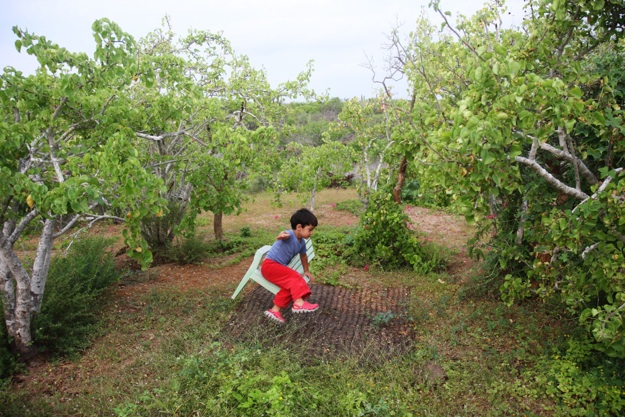
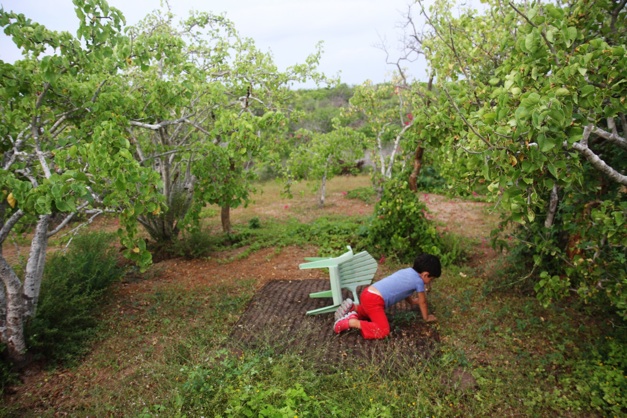
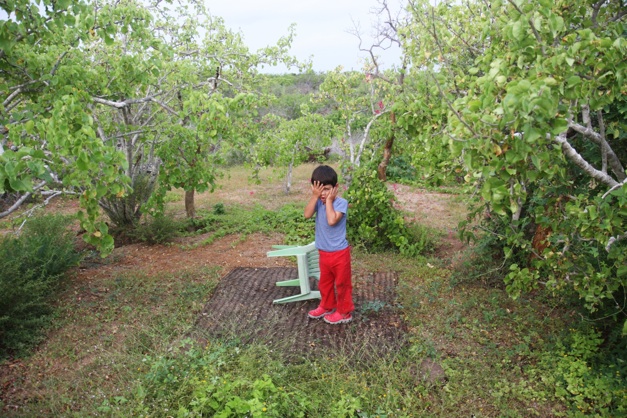

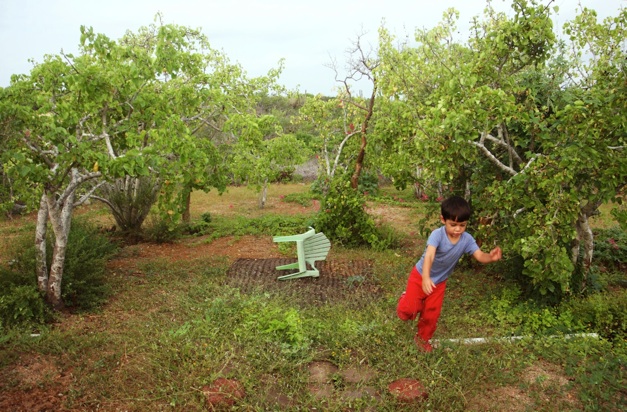
The Slow Making of a Dream: El Campo Elias Calles, The End of Camp
It was hard to see our beloved camp so destroyed, but I found relief in knowing I had documented it in its glory days. We also knew part of its beauty was its transience.
ZOELAB DAY 24
After six months of camping, and seven months of pregnancy, we decided that we needed to find a house to live in for the end of my pregnancy and the beginning of parenthood. I had met a woman who had taken pity on us, and offered to let us live in a casita on her property in another town in exchange for basic caretaking. We moved in and soon made ourselves a little nest. (For a post about the summer of 2009 and Jimena see Day 1.) A few weeks after Emilio was born Hurricane Jimena hit Baja a few hundred miles north of where we were. The destruction wasn’t devastating in our area, though there was some destruction. After the hurricane, which was a few months after we had left camp, we decided to go back see what had happened to our land. We had half abandoned our camp--we had been in such a rush to make a home for ourselves indoors we hadn’t even bothered to pack away our tents. We had left them out in the open to disintegrate in the sun, and then be blown around by the storm. Everything was a mess.
It was hard to see our beloved camp so destroyed, but I found relief in knowing I had documented it in its glory days. We also knew part of its beauty was its transience.
This is what the circle of trees looked like that day (to see the circle of trees in the spring, click:)
The next year, we also re-discovered the forgotten superhero nativity scene and fake christmas tree that our friends Jeremy and Charlotte had brought for the Christmas we had spent at camp (which was also our first night at camp.)
The next year, we also re-discovered the forgotten superhero nativity scene and fake christmas tree that our friends Jeremy and Charlotte had brought for the Christmas we had spent at camp (which was also our first night at camp.)
Three years have passed since the summer of Hurricane Jimena, and now another hurricane--Miriam--is due to hit Baja this week. Lucas and his sister are heading out tomorrow to drive up the Baja with an empty trailer. Their plan is to get North before the hurricane hits. Lucas is going to get the last of our stuff from our storage space and drive it down. I’ll be excited to reunite with it. Among what I remember of our belongings, there are four vintage pachinko machines, my journals, and Lucas’ incredible collection of rare art books. This also means nine days of a certain kind of aloneness. I’ll use art and creativity and compassion to make the best of it.
The Story of Elias Calles to be continued....
The Slow Making of a Dream: El Campo Elias Calles, Part Two
Having been a city girl my whole life, it was a real shift for me to live in nature.
ZOELAB DAY 23
“It was extraordinarily peaceful to be pregnant and surrounded by nothing but vast amounts of sky, desert, ocean and mountains.”
Our campsite continued to develop over the months we were there. Eventually Lucas made a mediation and yoga spot for me. Spring came, and the trees started to spring leaves. We found a beautiful arrangement of elephant and paper trees that naturally made a semicircle. Both kinds of trees are short, and they had no leaves because it was winter. The paper tree has peeling skin that is very fun to peel, but apparently once you peel it always stays smooth. We cleared around this circle of trees so that it would be more noticeable.
At the time I was avidly collecting rocks, shells and small animal bones that I had found in the area. I started arranging these around the circle of trees. Having been a city girl my whole life, it was a real shift for me to live in nature. I became very fond of it. It was extraordinarily peaceful to be pregnant and surrounded by nothing but vast amounts of sky, desert, ocean and mountains. The simplicity of life was comforting, even if I wasn’t always comfortable.
The Slow Making of a Dream: El Campo Elias Calles, Part One
I’ve been putting off telling this story even though it’s the story that I most want to tell. It’s a difficult story to tell because it’s complicated, and we’re still in the middle of it.
ZOELAB DAY 22
I've been putting off telling this story even thought it's the story I most want to tell. It's a difficult story to tell because it's complicated, and we're still in the middle of it. And also because it occurred (with many breaks in between) over several years, and I documented it thoroughly (not knowing what I'd do with all the images.) I just spent an hour looking through 2,283 images (photos & videos) that I have taken so far of our land, and the surrounding area of Elias Clales.
I have another more recent impetus to tell this story because an artist friend, Tia Factor, who makes uniquely gorgeous paintings, is doing a project where she asks people to describe a place that they have been to, and often return to in their imagination. The place represents comfort in the person’s imagination, so the person returns to it over and over in his/her mind. Then, after doing some image research, Tia makes a painting of the place based on the person’s description. I had wanted to participate in this project, but I hadn’t been able to think of a place that I had returned to over and over in my mind. But then I realized I did. Elias Calles is that place, even though I live here now. For so many years it was an imagined place, imagined and experienced from so many different perspectives, a place that contained hopes and dreams, and then loss of those same hopes and dreams. And even though we still continue to live here, there is so much about it that is still in our imaginations. All of our plans yet to be realized. This is what I wrote as my description to Tia (plus a few more words) for her painting:
Elias Calles is a hard place to describe because it is not like anywhere else I have ever been. I don't really have a point of reference. I had first heard of it from Lucas about five years ago. He told me he found a piece of land he wanted to buy in Mexico with some money he inherited from his grandmother. We thought of it as an investment. A few years later, we decided that we wanted to build a house on our land, move to Mexico, get married, and have a baby. This was all before I had even seen our land. I had been to Baja only once in 2004, after we had left New York City and before we were to move to San Francisco. It was a different part of Baja, and I had had a difficult time. (Another story for another time). I am not sure exactly what made me want to do something so uncertain, other than I was done with the particular chapter of our life, and we both wanted the experience of living in a different country and having a child. It was an intuitive decision based on what felt right. The plan was that Lucas (who had been going down to Baja often for many years) was going to build us a rudimentary house out of earth bags the year before we moved. He got started that year, but he was never able to finish. We were going to live in our house, try to have a baby when we got there, and then build ourselves a life. Things went a little differently then we had planned. I was a few days aware of being pregnant as we drove the 1,500 miles to Southern Baja from Northern California in our fully packed 1985 Toyota Landcruiser with our dog, Ping. During our journey, the World economy collapsed, two of our tires exploded, (we were saved within five minutes of our first tire exploding by Los Angeles Verdes--a Government road side assistance group that drives up and down the highway helping people with car trouble) and the frame of our car cracked as we literally pulled into our destination.
The first time I saw Elias Calles was in early December, 2008, a few days after we moved to Mexico. When I first saw it, I have to say I was disappointed. It looked like a scary, poisonous forest from a Disney movie. All plants had large points sticking out of them, everything was brown, and dry. There was nothing cleared on the land.—it was a dense low forest of shrubbery and cactus. I could not see the beauty--at first. I just didn't get it. Lucas was going to build us a campsite (because the house wasn’t ready and we didn’t really have the money to build). We started clearing the land with the help of our French friends Charlotte and Jeremy, who had made a little campsite on their piece of land nearby. Charlotte saw how uncertain I was, and tried to reassure me by saying that you created your little spaces out of the land and it starts to become yours. Fortunately for us, our friends allowed us to stay in their house in a nearby town, for our first month here, which was my most nauseous month, while Lucas built our campsite.
Lucas began to build our campsite--we cleared two 12 by 12 areas with the help of our French friends and Lucas’ sister (who is co-owner of the land). He made a temporary floor out of adoquin (red colored cement hexagons). We put our sleeping tent on one. And the other became our kitchen. To create shade for the sleeping tent, Lucas created a tensile structure, using large pine poles and a tarp. To create a space for the kitchen, we put up a four post canvas tent and screen walls. We filled the kitchen with a small folding table covered with bright Mexican oil cloth, for eating, a wooden freestanding counter for cooking, a high intensity 2 burner metal camping stove, a vintage 1920's sink resting on two tables (this sink is now in our kitchen), with a drain that went into a bucket. We also had our water tank on top of our broken landcruiser (it could no longer be driven after we arrived.) which Lucas filled by climbing up a ladder, and pouring water jugs into it. The water pressure was great, due to the high flow, gravity water pressure system. Our water drained out into a bucket below the sink which we dumped on the trees around the campsite. We also had sleeping tent that was large enough to stand in, and fit a closet and queen size mattress. This was deluxe camping.
Our campsite developed over the months we were there. Lucas hooked up a solar panel, and we had enough electricity to charge our laptops and have LED Christmas lights on at night. Our kitchen was fully functional and we were able to create delicious meals. We had our families and friends come to visit us in our little desert oasis--some who had never camped before in their lives and fell in love with the experience.
To be continued in next post...
Do it Yourself
Yesterday, we spent most of the day at home. It rained intermittently all day, a perfect excuse to go nowhere. What did we do? We drew pictures. We ate a snack plate for lunch. We made play dough. Not this is not revolutionary, but it certainly is fun.
DAY 4
Yesterday, we spent most of the day at home. It rained intermittently all day, a perfect excuse to go nowhere. What did we do? We drew pictures. We ate a snack plate for lunch. We made play dough. Not this is not revolutionary, but it certainly is fun. Making things yourself is so much more satisfying then buying them. And.... it saves money! It also creates an additional activity for you to share with your child. Its empowering for them to be involved in projects--it gives them a sense of mastery over their universe. Its also satisfying to make the colors you want to make with adding food dye. I love the two colors we made: bright mustard yellow and internal organ pink. Everything I made with the pink one made me think of the stuff inside our body.
Here is the recipe we used which we found on the web:
2 cups flour
2 cups warm water
1 cup salt
2 Tablespoons vegetable oil
1 Tablespoon cream of tartar (optional for improved elasticity)
food coloring (liquid, powder, or unsweetened drink mix)
scented oils
We didn’t use the scented oils. But it’s a good idea! You are supposed to heat all ingredients in pot and mix until it looks like mashed potatoes. Then you wait for it to cool and then knead with your hands to make it smooth. You can keep it in the fridge to prolong freshness. We made half the recipe--it came out a little lumpy, but next time I’ll use a smaller pot and less heat and I think it will work better.
The other thing I did was draw spider webs because I want the Web Map page of this site (each link will be in the center of each web) to be hand drawn. It was very fun to draw spider webs--I had never done it before. But I am not yet happy with it as the web page. I might try again and create more space between each web cluster. Here’s what I did:
I wanted to find a spider, put it on top of the drawing, and take a photo, but my husband thought that it was not a good idea as there are some pretty poisonous spiders out there. We’ll see...
We did have a good gecko sighting near our palapa--which really is a daily occurrence. Sometimes they attack each other.



































































